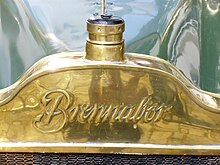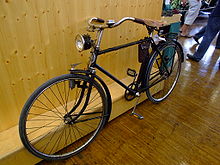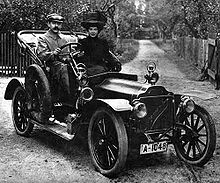Brennabor
| Brennabor-Werke AG | |
|---|---|
| legal form | Corporation |
| founding | 1871 (as Brennabor-Werke Gebr. Reichstein ) |
| resolution | 1945 |
| Reason for dissolution | Dismantling of the plant after the Second World War |
| Seat | Brandenburg an der Havel , Germany |
| Number of employees |
|
| Branch | Stroller manufacturers , bicycle manufacturers , motor vehicle manufacturers |
The Brennabor-Werke Gebr. Reichstein , later Brennabor-Werke AG , were a German manufacturer of prams , bicycles , cars and motorcycles based in Brandenburg an der Havel . The name of the company goes back to the supposedly old (but incorrect) name of the city of Brandenburg .
history
The brothers Adolf, Carl and Hermann Reichstein founded the company in 1871. Like their father, who died in 1862 and whose business they continued, the three trained basket makers. In order to expand the business beyond baskets and to be independent of suppliers, joinery, wheelwright, locksmith's and blacksmith's were added to the basket-making shop, so that on April 21, 1871, the production of complete prams began. The company's workforce increased to 300 within the first three years.
From the 1880s onwards, the Reichsteins also produced bicycles, which were given the brand name Brennabor in 1888.
Until the 1930s, Brennabor was the largest manufacturer of strollers in Europe and one of the largest bicycle factories.
From 1901 the works also produced motorcycles in series, from 1903 motor vehicles (initially only on order) with three and four wheels. Series production of automobiles began in 1908. No automobiles were produced during the First World War , motorcycles initially only until 1916.
The Brennabor factory had its own racing team from 1908 and achieved great success in motorsport worldwide .
In 1919 the P type mid-range car was presented, for which large-scale production began in 1921. In the early to mid-1920s, Brennabor had risen to become the largest automobile manufacturer in Germany, and until 1927/28 it was still the second largest behind Opel . The company employed 6,000 workers in 1924.
In 1919, under the leadership of Sigmund Meyer, Brennabor merged with NAG and Hansa-Lloyd to form the Kartell Gemeinschaft Deutscher Automobilfabriken (GDA). This sales organization existed until 1928, but did not lead to a permanent merger of the companies involved.
Brennabor was one of the first German automobile manufacturers to introduce assembly line production in 1923/24. The global economic crisis ensured that production figures fell, especially since no small car was on offer. The vehicles first equipped with front-wheel drive vehicles (according to Voran patents) in 1931 only resulted in a prototype based on the Juwel 6 type . Series production was no longer possible for financial reasons. In 1932, automobile production was initially interrupted for eight months, briefly resumed in late autumn with new models and finally discontinued in 1933. In 1932 the Brennabor works were converted into an AG.
The company had six sales offices in Berlin and one in Potsdam .
From 1930 to 1942, Brennabor produced light motorcycles with built-in engines from Fichtel & Sachs , from 1939 also with their own engines (model G 100) and bicycles until 1945. Armaments were also produced; for example the 2 cm Flak 38 . The company's history ended with the dismantling of the plant after the Second World War in 1945.
Brennabor products have been exported to Australia, China, South America, South Africa and all of Europe.
The Brandenburg Tractor Works then established themselves on the factory premises, producing wheeled and chain tractors until 1964 and then switching production to commercial vehicle transmissions. The Brandenburg transmission plant has been a subsidiary of ZF Friedrichshafen since 1991 . ZF maintains an apprentice training facility at the former plant. The Central Subsidy Office for Retirement Assets (ZfA) has also been working there since 2018, and is responsible nationwide for promoting the Riester pension.
New registrations of Brennabor cars in the German Reich from 1933 to 1938
| year | Registration numbers |
|---|---|
| 1933 | 921 |
| 1934 | 222 |
| 1935 | |
| 1936 | 3 |
| 1937 | |
| 1938 | 2 |
Source:
Car models
| Type | Construction period | cylinder | Displacement | power | Vmax |
|---|---|---|---|---|---|
| Type A1 3.5 / 8 PS | 1905-1911 | 2 row | 904 cc | 6-8 hp (5.9 kW) | 50 km / h |
| Brennaborette 3.5, 4 and 5.5 HP | 1907-1912 | 1 cyl. with 3.5 and 4 hp, 2 cyl. with 5.5 hp | 452 cc | 3.5 (2.6 kW), 4 and 5.5 hp | 35 km / h |
| Small cars 6/12 and 6/14 hp | 1908-1910 | 4 row | 12-14 hp | 70 km / h | |
| Type D 10/20 and 10/24 (Prinz Heinrich Wagen) |
1910-1911 | 4 row | 20 and 24 hp | 80 km / h | |
| Type B 5/12 PS | 1911-1913 | 4 row | 1328 cc | 12 HP (8.8 kW) | 55 km / h |
| Type L 6/18 PS | 1911-1914 | 4 row | 1592 cm³ | 18 hp (13.2 kW) | 60 km / h |
| Type C 6/18 PS | 1910-1912 | 4 row | 18 hp | 65 km / h | |
| Type G 8/22 PS | 1910-1914 | 4 row | 2025 cm³ | 22 hp (16.2 kW) | 70 km / h |
| Type F 10/28 PS | 1911-1914 | 4 row | 2476 cc | 28 hp (20.6 kW) | 80 km / h |
| Type M 6/16 PS | 1914 | 4 row | 1453 cc | 16 hp (11.8 kW) | 70 km / h |
| Type P 8/24 PS | 1919-1925 | 4 row | 2091 cc | 24 hp (17.7 kW) | 65 km / h |
| Type S 6/20 PS | 1922-1925 | 4 row | 1569 cc | 20 hp (14.7 kW) | 70 km / h |
| Type R 6/25 PS | 1925-1928 | 4 row | 1569 cc | 25 hp (18.4 kW) | 70 km / h |
| Type P 8/32 PS | 1925-1927 | 4 row | 2091 cc | 27 PS (19.9 kW) | 75 km / h |
| Type AL 10/45 PS | 1927-1930 | 6 row | 2547 cc | 45 hp (33 kW) | 70 km / h |
| Type Z 6/25 PS | 1927-1929 | 4 row | 1569 cc | 25 hp (18.4 kW) | 70 km / h |
| Type AK 10/45 PS | 1927-1930 | 6 row | 2547 cc | 45 hp (33 kW) | 85 km / h |
| Type ASK / Type AFK 12/55 PS | 1928-1932 | 6 row | 3080 cc | 55 HP (40 kW) | 90 km / h |
| Type ASL / type AFL 12/55 PS | 1928-1932 | 6 row | 3080 cc | 55 HP (40 kW) | 85 km / h |
| Ideal 7/30 hp | 1929-1933 | 4 row | 1640 cc | 30 HP (22 kW) | 75 km / h |
| Juwel 6 10/45 hp | 1929-1932 | 6 row | 2460 cc | 45 hp (33 kW) | 85 km / h |
| Juwel 8 14/60 and 14/65 hp | 1930-1932 | 8 row | 3417 cc | 60 hp (44 kW) | 100 km / h |
| Juwel Front 10/45 HP | Prototype 1931 | 6 row | 2460 cc | 45 hp | 85 km / h |
| Type C 4/20 | 1931-1933 | 4 row | 995 cc | 20 hp (14.7 kW) | 75 km / h |
| Ideal extra 7/30 hp | 1930-1933 | 4 row | 1640 cc | 30 HP (22 kW) | 75 km / h |
| Type D 4/22 | 1933 | 4 row | 995 cc | 22 hp (16.2 kW) | 75 km / h |
| Type E 8/38 PS | 1933 | 6 row | 1957 cc | 38 hp (27.9 kW) | 80 km / h |
| Type F 10/45 PS | 1933 | 6 row | 2460 cc | 45 hp (33 kW) | 90 km / h |
Stamp after 1945
In the 1950s, the Brennabor brand reappeared in mopeds in West German production, produced by Brennabor Fahrzeugwerke mbH , whose factory was located at Banksstrasse 20-26 in Hamburg . Among other things, there was a Brennabor FP 5 model from 1953 to 1955 . In the 1990s and 2000s, Brennabor was used as a trademark for bicycles from various manufacturers.
literature
- Archive Mario Steinbrink, Brennabor Brandenburg Interest Group, www.brennabor-brb.de
- Werner Oswald : German cars. Volume 2: 1920-1945. 2nd Edition. Motorbuch-Verlag, Stuttgart 2005, ISBN 3-613-02170-6 .
- Bertold Pavel, Frank Brekow, Bernd Krause: From Brennabor to ZF Brandenburg. An industrial story. Brandenburgisches Verlagshaus, Berlin 1996, ISBN 3-89488-107-0 .
- Fred Frank Stapf, Renate Stapf, Roger Daniel: Brennabor. From basket maker to car king. From the life of the Reichstein family of industrialists 1839–1971. Kerschsteiner Verlag, Lappersdorf 2005, ISBN 3-931954-12-9 .
Web links
Individual evidence
- ↑ http://www.brennabor-brb.de/start.htm
- ↑ https://www.gtue-oldtimerservice.de/automobil/marke/BRENNABOR/141/
- ^ German biography: Reichstein, Carl Eduard Robert
- ↑ Brennabor . In Automodelle , catalog 1970/71, Vereinigte Motorverlage, Stuttgart 1970, pp. 54–56.
- ↑ Local history sheets 2016, VFV-Info issue 1/2016.
- ^ Christoph Graf von Seherr-Thoß: Meyer, Sigmund (called Hans Sigismund). In: New German Biography (NDB). Volume 17, Duncker & Humblot, Berlin 1994, ISBN 3-428-00198-2 , p. 373 f. ( Digitized version ).
- ^ Advertisement by Gebr. Reichstein Brennabor-Werke in Deutsche Allgemeine Zeitung , April 1929.
- ^ Hans Christoph von Seherr-Thoss : The German automobile industry. Documentation from 1886 until today . Deutsche Verlags-Anstalt, Stuttgart 1974, ISBN 3-421-02284-4 , p. 328 .
- ↑ Brigitte Podszun: Mopeds of the economic boom . Podszun Verlag, Brilon, 2010 edition. ISBN 978-3-86133-276-3






